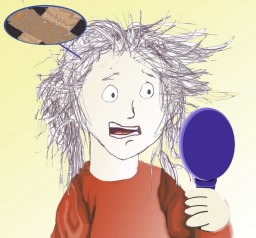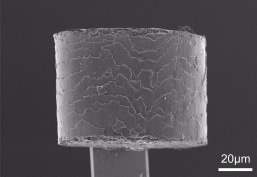FOR IMMEDIATE RELEASE | August 17, 2008
Heads-up study of hair dynamics may lead to better hair-care products
PHILADELPHIA, Aug. 17, 2008 — From frizzy perms to over-bleached waves, “bad hair days” could soon become a less frequent occurrence. Chemists report the first detailed microscopic analysis of what happens to individual hair fibers when they interact with each other, an advance in knowledge key to the development of improved shampoos, conditioners, and other products for repairing damaged hair, the researchers say. They presented the study here today at the American Chemical Society’s 236th National Meeting.
Embracing that adage, “Personal care begins with hair,” consumers now spend almost $60 billion annually on hair care products, one of the personal care industry’s largest market segments. Despite the increasing availability of new hair care products within the past century, many products are inadequate for tackling today’s rigorous hair treatments, the researchers say.
Contact
215-418-2407 (Philadelphia, Aug. 17-21)
202-872-4400 (Washington D.C.)
“Given all the new hair treatments out there, there’s a growing need to make hair feel more natural, especially for women,” says study co-author Eva Max, a doctoral student in chemistry at the University of Bayreuth in Germany. She notes, however, that researchers still are scrambling to put hair care on a firm scientific basis. The research involves “haptics,” the science of touch — how the subjective perception of touch connects to objective surface properties of hair and other materials
“For the first time, we present an experimental setup that allows measuring the subtle forces, both physical and chemical, that arise when single hairs slide past each other or are pressed against each other,” Max says. “The findings will help provide clearer strategies for optimizing hair care products.”
Max points out that conventional methods for testing the effectiveness of hair care products involve measuring the forces required to comb hair under standardized laboratory conditions. Test volunteers are also asked to assess hair feel, but this approach is largely subjective. A more scientific way to study hair conditioning is needed, the researchers say.
In the new study, the researchers invented a unique technology for analyzing hair that involves mounting individual hair fibers on a cantilever tip of an atomic force microscope and measuring their interactions as they touch each other. “The system will allow scientists to explore how different hair care products affect hair-to-hair interactions so that these products can be optimized in a more systematic fashion,” Max says.

The researchers used this new technique to analyze hair samples collected from volunteers. The samples, which were previously bleached, ranged from light blond to dark blonde in color.
The researchers found that hair feels rough and difficult to comb for two main reasons. On the one hand, mechanical damage to a hair’s surface, or cuticle, creates scaly projections that jut out at perpendicular angles to other hair fibers. When hair fibers slide past each other, these scales create more friction than smooth hairs, causing a rough feel and making hair more difficult to comb. To soften hair, conditioners must contain active agents to smooth-out these scales so that they produce less friction, the researchers say.
On the other hand, chemical changes occur when hair fibers interact. Negative charges build up on the surface of hair that causes repulsion between single hairs. This repulsion causes friction and makes hair rough and difficult to comb. To solve the problem, positively-charged polymers that neutralize the negatively charged surfaces are included in conditioner formula to provide a silky feel to hair.
But finding the right formula for repairing damaged hair is no easy task, notes Claudia Wood, Ph.D., a senior scientist at BASF in Bayreuth, Germany. In addition to hair interactions, many other external factors, such as humidity, water content of hair, and hair stickiness, all affect hair quality, Wood says.
The key to repairing these processes is to find the right ratio of beneficial components in a conditioner or shampoo that optimize hair feel, Max and colleagues say. This new method will allow developers of hair care products to achieve this goal more easily, giving consumers a more reliable product, the researchers say. Their study was funded by BASF Care Chemicals Division.
# # #
— Mark T. Sampson
Eva Max is a doctoral student in the Department of Physical Chemistry II, University of Bayreuth, Bayreuth, Germany.
Claudia Wood, Ph.D., is a senior scientist at BASF in Bayreuth, Germany.


